Climate Data
The Climate Data Guide is a high-traffic expert knowledge portal providing concise and reliable information on the data that are essential for monitoring and understanding the Earth System. Currently, it curates expert insights on over 200 observational datasets and indices, searchable or browseable in the list below.
To find a specific dataset or climate variable, jump to the the search box. For only the datasets paired with guidance written by experts, select the "Datasets with guidance" button when using the search box.
Data creators, data publishers, and scientists who use climate data are invited to join our Network of Experts by contributing commentaries on data strengths and limitations to the Climate Data Guide. What type of data are included? See this discussion.
With the exception of about 25 climate indices, the Climate Data Guide does not host datasets. Data cannot be downloaded from this site. However, links are provided to download locations under the "Data Access" section of each dataset page.
Citation: Please link to this website in your work that draws upon material from this website, and cite this paper:
Schneider, D. P., C. Deser, J. Fasullo, and K. E. Trenberth, 2013: Climate Data Guide Spurs Discovery and Understanding. Eos Trans. AGU, 94, 121–122, https://doi.org/10.1002/2013eo130001.
=> Additionally, each dataset page with expert-written guidance has its own citation example on the individual page, such that the experts who wrote the guidance may be credited. Finally, responsible use and citation of datasets is strongly encouraged.
Climate datasets
 Nino SST Indices (Nino 1+2, 3, 3.4, 4; ONI and TNI)
Nino SST Indices (Nino 1+2, 3, 3.4, 4; ONI and TNI)
Years of Record
- 1870-01 to 2023-04
There are several indices used to monitor the tropical Pacific, all of which are based on sea surface temperature (SST) anomalies averaged across a given region. Usually the anomalies are computed relative to a base period of 30 years. The Niño 3.4 index…
-
Formats
- ascii
-
Timestep
- Monthly
-
Domain
- Pacific Ocean, Tropics
-
Collections
- Climate Analysis Section (CAS) Data Catalog
Experts contributing reviews
- Trenberth, Kevin
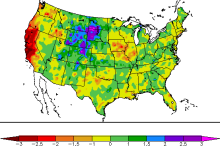 Standardized Precipitation Index (SPI)
Standardized Precipitation Index (SPI)
Years of Record
- 1949-01 to 2018-07
The Standardized Precipitation Index (SPI) is a widely used index to characterize meteorological drought on a range of timescales. On short timescales, the SPI is closely related to soil moisture, while at longer timescales, the SPI can be related to groundwater and…
-
Formats
-
Timestep
- Monthly
-
Domain
-
Collections
- None
Experts contributing reviews
- Keyantash, John
 Palmer Drought Severity Index (PDSI)
Palmer Drought Severity Index (PDSI)
Years of Record
The Palmer Drought Severity Index (PDSI) uses readily available temperature and precipitation data to estimate relative dryness. It is a standardized index that generally spans -10 (dry) to +10 (wet). Maps of operational agencies like NOAA typically show a range of -4 to…
-
Timestep
- Monthly
-
Domain
- Global
-
Collections
- Climate Analysis Section (CAS) Data Catalog
Experts contributing reviews
- Dai, Aiguo | Bui, Sang | Lenssen, Nathan
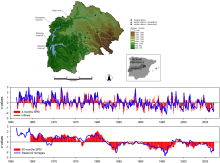 Standardized Precipitation Evapotranspiration Index (SPEI)
Standardized Precipitation Evapotranspiration Index (SPEI)
Years of Record
- 1901-01 to 2014-03
The Standardized Precipitation Evapotranspiration Index (SPEI) is an extension of the widely used Standardized Precipitation Index (SPI). The SPEI is designed to take into account both precipitation and potential evapotranspiration (PET) in determining drought. Thus,…
Main variables and Earth System components
Experts contributing reviews
- Vicente-Serrano, Sergio M.
 Atlantic Multi-decadal Oscillation (AMO) and Atlantic Multidecadal Variability (AMV)
Atlantic Multi-decadal Oscillation (AMO) and Atlantic Multidecadal Variability (AMV)
Years of Record
- 1870-01 to 2021-03
The Atlantic Multi-decadal Oscillation (AMO) has been identified as a coherent mode of natural variability occurring in the North Atlantic Ocean with an estimated period of 60-80 years. It is based upon the average anomalies of sea surface temperatures (SST) in the North…
-
Timestep
- Monthly, Decadal
-
Collections
- Climate Analysis Section (CAS) Data Catalog
Experts contributing reviews
- Trenberth, Kevin | Zhang, Rong
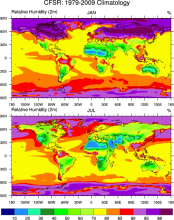 Climate Forecast System Reanalysis (CFSR)
Climate Forecast System Reanalysis (CFSR)
Years of Record
- 1979-01 to 2017-11
The CFSR is a third generation reanalysis product. It is a global, high resolution, coupled atmosphere-ocean-land surface-sea ice system designed to provide the best estimate of the state of these coupled domains over this period. The CFSR includes (1) coupling of…
Main variables and Earth System components
Atmosphere Air Temperature Geopotential Height Precipitable water Ocean-
Formats
- GRIB
-
Timestep
- Sub-daily, Monthly
-
Domain
- Global
-
Collections
- Climate Analysis Section (CAS) Data Catalog
Experts contributing reviews
- None
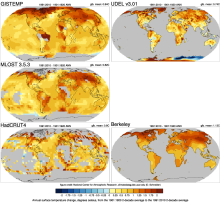 Global Temperature Data Sets: Overview & Comparison Table
Global Temperature Data Sets: Overview & Comparison Table
Years of Record
- 1850-01 to 2013-10
Global surface temperature data sets are an essential resource for monitoring and understanding climate variability and long-term trends. The most commonly used data sets combine historical observations of near surface air temperatures at land stations with global data…
Main variables and Earth System components
Atmosphere Air Temperature Air Temperature at 2m Ocean SST - sea surface temperature-
Timestep
- Climatology, Monthly
-
Domain
- Global
-
Collections
- Overview / Comparison page
Experts contributing reviews
- None
 PRISM High-Resolution Spatial Climate Data for the United States: Max/min temp, dewpoint, precipitation
PRISM High-Resolution Spatial Climate Data for the United States: Max/min temp, dewpoint, precipitation
Years of Record
- 1895-01 to 2023-04
PRISM is a set of monthly, yearly, and single-event gridded data products of mean temperature and precipitation, max/min temperatures, and dewpoints, primarily for the United States. In-situ point measurements are ingested into the PRISM (Parameter elevation Regression on…
Main variables and Earth System components
Atmosphere Dew Point Temperature Maximum Air Temperature Minimum Air Temperature Precipitation-
Formats
- ARC/INFO ASCII GRID | netCDF
-
Timestep
- Climatology, Daily, Monthly
-
Domain
- North America
-
Collections
- None
Experts contributing reviews
- Daly, Christopher
 Pacific Decadal Oscillation (PDO): Definition and Indices
Pacific Decadal Oscillation (PDO): Definition and Indices
Years of Record
- 1900-01 to 2015-12
The Pacific Decadal Oscillation (PDO) is defined by the leading pattern (EOF) of sea surface temperature (SST) anomalies in the North Pacific basin (typically, polewards of 20°N). The SST anomalies are obtained by removing both the climatological annual cycle and…
-
Formats
- ascii
-
Timestep
- Monthly
-
Domain
- Pacific Ocean
-
Collections
- None
Experts contributing reviews
- Deser, Clara | Trenberth, Kevin
 ERA5 atmospheric reanalysis
ERA5 atmospheric reanalysis
Years of Record
- 1940-01 to 2023-07
ERA5, the successor to ERA-Interim, provides global, hourly estimates of atmospheric, ocean-wave and land-surface variables, at a horizontal resolution of 31 km and 137 levels in the vertical from the surface to 0.01 hPa (about 80km). Produced by ECMWF on behalf of the…
-
Timestep
- Sub-daily, Daily, Monthly
-
Domain
- Global
-
Collections
- Diagnostic Data Sets
Experts contributing reviews
- Hersbach, Hans
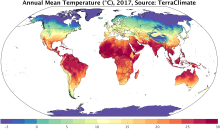 TerraClimate: Global, high-resolution gridded temperature, precipitation, and other water balance variables
TerraClimate: Global, high-resolution gridded temperature, precipitation, and other water balance variables
Years of Record
- 1958-01 to 2018-12
TerraClimate is a global gridded dataset of meteorological and water balance variables for 1958-present, available on a monthly timestep. Its relatively fine spatial resolution, global extent, and long length are a unique combination that fills a void in climate data…
Main variables and Earth System components
Atmosphere Air Temperature Maximum Air Temperature Minimum Air Temperature Potential Evapotranspiration Precipitation Wind Snow Water Equivalent Land evapotranspiration Runoff and Streamflow Soil MoistureExperts contributing reviews
- Abatzoglou, John
 Precipitation Data Sets: Overview & Comparison table
Precipitation Data Sets: Overview & Comparison table
Years of Record
Precipitation (rain, snow, hail, ...) is one of the key components of the hydrological cycle. Its societal importance cannot be over stated. For climate research, precipitation is one of the key terms for balancing the energy budget, and one of the most challenging…
-
Formats
-
Timestep
-
Domain
-
Collections
- Overview / Comparison page
Experts contributing reviews
- None
 JRA-55
JRA-55
Years of Record
- 1957-12 to 2022-02
Spanning 1958-present, JRA-55 is the longest third-generation reanalysis that uses the full observing system (in contrast, products like ERA-20C and NOAA 20CR assimilate a very limited set of observations while NCEP R1 uses an antiquated model and assimilation scheme).…
Main variables and Earth System components
Atmosphere Air Temperature Geopotential Height Precipitable waterExperts contributing reviews
- Kobayashi, Shinya
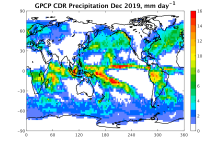 GPCP (Monthly): Global Precipitation Climatology Project
GPCP (Monthly): Global Precipitation Climatology Project
Years of Record
- 1979-01 to 2020-07
Data from rain gauge stations, satellites, and sounding observations have been merged to estimate monthly rainfall on a 2.5-degree global grid from 1979 to the present. The careful combination of satellite-based rainfall estimates provides the most complete analysis of…
-
Timestep
- Climatology, Monthly
-
Domain
- Global
Experts contributing reviews
- Pendergrass, Angeline | Wang, Jian-Jian
 IBTrACS: Tropical cyclone best track data
IBTrACS: Tropical cyclone best track data
Years of Record
IBTrACS (International Best Track Archive for Climate Stewardship) provides global tropical cyclone best track data in a centralized location to aid our understanding of the distribution, frequency, and intensity of tropical cyclones worldwide. The World Meteorological…
Experts contributing reviews
- Schreck, Carl
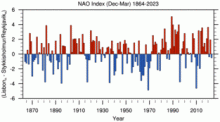 Hurrell North Atlantic Oscillation (NAO) Index (station-based)
Hurrell North Atlantic Oscillation (NAO) Index (station-based)
Years of Record
- 1865-01 to 2023-06
The winter (December thru March) station-based index of the NAO is based on the difference of normalized sea level pressure (SLP) between Lisbon, Portugal and Stykkisholmur/Reykjavik, Iceland since 1864. Positive values of the NAO index are typically associated with…
-
Formats
- ascii
-
Timestep
- Monthly, Seasonal, Annual
-
Domain
- Atlantic Ocean
-
Collections
- Climate Analysis Section (CAS) Data Catalog
Experts contributing reviews
- Hurrell, James | Phillips, Adam
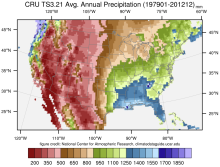 CRU TS Gridded precipitation and other meteorological variables since 1901
CRU TS Gridded precipitation and other meteorological variables since 1901
Years of Record
- 1901-01 to 2022-12
The CRU TS series of data sets (CRU TS = Climatic Research Unit Time series) contain gridded monthly fields of precipitation, daily maximum and minimum temperatures, cloud cover, and other variables covering Earth's land areas for 1901-2022 (CRU TS4.0 is the recent major…
Main variables and Earth System components
Atmosphere Air Temperature Cloud Properties Maximum Air Temperature Minimum Air Temperature Potential Evapotranspiration PrecipitationExperts contributing reviews
- None
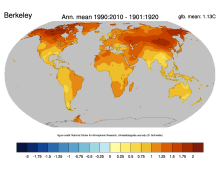 Global surface temperatures: BEST: Berkeley Earth Surface Temperatures
Global surface temperatures: BEST: Berkeley Earth Surface Temperatures
Years of Record
- 1701-01 to 2019-07
The Berkeley Earth Surface Temperatures (BEST) are a set of data products, originally a gridded reconstruction of land surface air temperature records spanning 1701-present, and now including an 1850-present merged land-ocean data set that combines the land…
Main variables and Earth System components
Atmosphere Air Temperature Maximum Air Temperature Minimum Air Temperature Ocean SST - sea surface temperatureExperts contributing reviews
- Cowtan, Kevin
 GPCC: Global Precipitation Climatology Centre
GPCC: Global Precipitation Climatology Centre
Years of Record
- 1891-01 to 2018-12
The GPCC provides gridded gauge-analysis products derived from quality controlled station data. Two products are for climate: (a) the Full Data Reanalysis Product (1901-2010) is recommended for global and regional water balance studies, calibration/validation of…
-
Timestep
- Climatology, Daily, Monthly
-
Domain
- Global
Experts contributing reviews
- None
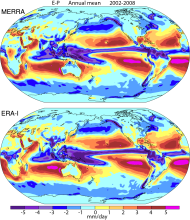 Atmospheric Reanalysis: Overview & Comparison Tables
Atmospheric Reanalysis: Overview & Comparison Tables
Years of Record
Reanalysis a systematic approach to produce data sets for climate monitoring and research. Reanalyses are created via an unchanging ("frozen") data assimilation scheme and model(s) which ingest all available observations every 6-12 hours over the period being analyzed.…
Main variables and Earth System components
Atmosphere-
Formats
-
Timestep
-
Domain
Experts contributing reviews
- Dee, Dick | Fasullo, John | Shea, Dennis | Walsh, John
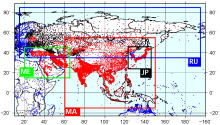 APHRODITE: Asian Precipitation - Highly-Resolved Observational Data Integration Towards Evaluation of Water Resources
APHRODITE: Asian Precipitation - Highly-Resolved Observational Data Integration Towards Evaluation of Water Resources
Years of Record
- 1951-01 to 2015-12
APHRODITE’s (Asian Precipitation - Highly-Resolved Observational Data Integration Towards Evaluation) gridded precipitation is a set of long-term (1951 onward) continental-scale daily products that is based on a dense network of rain-gauge data for Asia including the…
Experts contributing reviews
- Maeda, Mio | Yasutomi, Natsuko | Yatagai, Akiyo
 SST data: HadiSST v1.1
SST data: HadiSST v1.1
Years of Record
- 1870-01 to 2021-12
The Hadley Centre Global Sea Ice and Sea Surface Temperature (HadISST) is a combination of monthly globally complete fields of SST and sea ice concentration for 1871-present. This page focuses on the SST data; see the separate page for discussion of HadISST sea ice.…
-
Timestep
- Monthly
-
Domain
- Global
Experts contributing reviews
- None
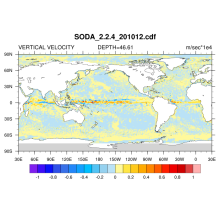 SODA: Simple Ocean Data Assimilation
SODA: Simple Ocean Data Assimilation
Years of Record
- 1870-01 to 2010-12
The Simple Ocean Data Assimilation, or SODA, analysis is an ocean reanalysis data set consisting of gridded variables for the global ocean, as well as several derived fields. The goal is to provide an improved estimate of ocean state from those based solely on…
Main variables and Earth System components
Wind Stress Ocean 3D Velocity potential temperature Salinity sea surface height SST - sea surface temperature u, v current componentsExperts contributing reviews
- None
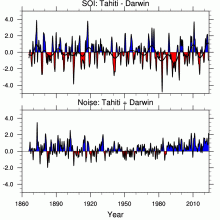 Southern Oscillation Indices: Signal, Noise and Tahiti/Darwin SLP (SOI)
Southern Oscillation Indices: Signal, Noise and Tahiti/Darwin SLP (SOI)
Years of Record
- 1866-01 to 2025-03
The Southern Oscillation Index (SOI) is a time series used to characterize the large scale sea level pressure (SLP) patterns in the tropical Pacific. Monthly mean SLP at Tahiti [T] and Darwin [D] are used. An optimal SOI can be constructed. It consists of [T-D]…
-
Timestep
- Monthly
-
Domain
- Australia, Pacific Ocean, Tropics
-
Collections
- Climate Analysis Section (CAS) Data Catalog
Experts contributing reviews
- Trenberth, Kevin
 TRMM: Tropical Rainfall Measuring Mission
TRMM: Tropical Rainfall Measuring Mission
Years of Record
- 1998-01 to 2019-12
The Tropical Rainfall Measuring Mission (TRMM) is a joint space mission between NASA and Japan's National Space Development Agency designed to monitor and study tropical and subtropical precipitation and the associated release of energy. The mission uses 5 instruments:…
-
Timestep
- Sub-daily, Daily, Monthly
-
Domain
- Tropics
-
Collections
- Climate Analysis Section (CAS) Data Catalog, Obs4MIPS
Experts contributing reviews
- Huffman, George J. | Pendergrass, Angeline
 NASA's MERRA2 reanalysis
NASA's MERRA2 reanalysis
Years of Record
- 1980-01 to 2017-11
The Modern-Era Retrospective analysis for Research and Applications, version 2 (MERRA-2) is a global atmospheric reanalysis produced by the NASA Global Modeling and Assimilation Office (GMAO). It spans the satellite observing era from 1980 to the present. The goals of…
Main variables and Earth System components
Atmosphere Aerosols Air Temperature Geopotential Height Precipitable waterExperts contributing reviews
- Bosilovich, Michael | Cullather, Richard
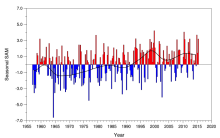 Marshall Southern Annular Mode (SAM) Index (Station-based)
Marshall Southern Annular Mode (SAM) Index (Station-based)
Years of Record
- 1957-01 to 2015-09
The station-based index of the Southern Annular Mode (SAM) is based on the zonal pressure difference between the latitudes of 40S and 65S. As such, the SAM index measures a "see-saw" of atmospheric mass between the middle and high latitudes of the Southern…
-
Formats
- ascii
-
Timestep
-
Collections
- None
Experts contributing reviews
- Marshall, Gareth
 SST data: NOAA High-resolution (0.25x0.25) Blended Analysis of Daily SST and Ice, OISSTv2
SST data: NOAA High-resolution (0.25x0.25) Blended Analysis of Daily SST and Ice, OISSTv2
Years of Record
- 1981-09 to 2022-02
"NOAA’s Optimum Interpolation Sea Surface temperature (OISST, also known as Reynolds’ SST) is a series of global analysis products, including the weekly OISST on a 1° grid to the more recent daily on a ¼° grid. An SST analysis is a spatially gridded product created by…
Main variables and Earth System components
Cryosphere Sea Ice Concentration Ocean SST - sea surface temperatureExperts contributing reviews
- Banzon, Viva | Reynolds, Richard
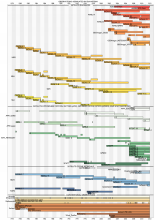 ERA-Interim
ERA-Interim
Years of Record
- 1979-01 to 2019-09
Using a much improved atmospheric model and assimilation system from those used in ERA-40, ERA-Interim represents a third generation reanalysis. Several of the inaccuracies exhibited by ERA-40 such as too-strong precipitation over oceans from the early 1990's onwards and…
Main variables and Earth System components
Atmosphere Air Temperature Geopotential Height Precipitable water Precipitation-
Timestep
- Sub-daily, Daily, Monthly
-
Domain
- Global
Experts contributing reviews
- Dee, Dick
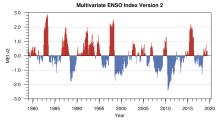 Multivariate ENSO Index
Multivariate ENSO Index
Years of Record
- 1979-01 to 2019-05
The Multivariate ENSO Index (MEI) is said to capture a more holistic representation of the atmospheric and oceanic anomalies that occur during ENSO events than do single-variables timeseries like the NinoSST indices. The MEIv2 is based on five variables from the tropical…
Main variables and Earth System components
-
Formats
- ascii
-
Timestep
- Monthly
-
Domain
- Pacific Ocean
-
Collections
- Climate Analysis Section (CAS) Data Catalog
Experts contributing reviews
- None
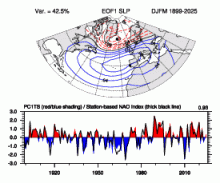 Hurrell North Atlantic Oscillation (NAO) Index (PC-based)
Hurrell North Atlantic Oscillation (NAO) Index (PC-based)
Years of Record
- 1899-01 to 2025-03
The principal component (PC)-based indices of the North Atlantic Oscillation (NAO) are the time series of the leading Empirical Orthogonal Function (EOF) of SLP anomalies over the Atlantic sector, 20°-80°N, 90°W-40°E. These indices are used to measure the NAO…
-
Formats
- ascii
-
Timestep
- Monthly, Seasonal, Annual
-
Domain
- Atlantic Ocean
-
Collections
- Climate Analysis Section (CAS) Data Catalog
Experts contributing reviews
- Hurrell, James | Phillips, Adam
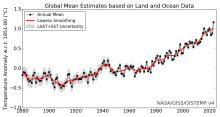 Global surface temperature data: GISTEMP: NASA Goddard Institute for Space Studies (GISS) Surface Temperature Analysis
Global surface temperature data: GISTEMP: NASA Goddard Institute for Space Studies (GISS) Surface Temperature Analysis
Years of Record
- 1880-01 to 2020-03
NASA Goddard's Global Surface Temperature Analysis (GISTEMP) combines land surface air temperatures from GHCN-M version 4 with SSTs of the ERSSTv5 analysis into a comprehensive, global surface temperature data set spanning 1880 to the present at monthly resolution, on a…
Main variables and Earth System components
Atmosphere Air Temperature Ocean SST - sea surface temperature-
Timestep
- Monthly
-
Domain
- Global
Experts contributing reviews
- Lenssen, Nathan
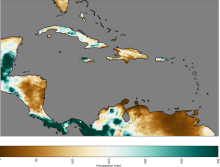 CHIRPS: Climate Hazards InfraRed Precipitation with Station data (version 2)
CHIRPS: Climate Hazards InfraRed Precipitation with Station data (version 2)
Years of Record
- 1981-01 to 2023-02
Note: CHIRPS v2 has been superseded by CHIRPS v3 as of June 2025. Climate Hazards Group InfraRed Precipitation with Station data (CHIRPS) is a quasi-global (50S - 50N), land-only rainfall dataset with a range of temporal and spatial resolutions depending on the region and…
Experts contributing reviews
- Touma, Danielle | Martinez, Carlos
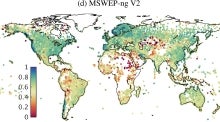 Global high-resolution precipitation: MSWEP
Global high-resolution precipitation: MSWEP
Years of Record
- 1979-01 to 2023-07
Multi-Source Weighted-Ensemble Precipitation (MSWEP) is a sub-daily precipitation dataset with full global coverage at 0.1° resolution, spanning the period 1979 to present. It is updated in near real-time with a latency of three hours, making it suitable for…
Experts contributing reviews
- Beck, Hylke
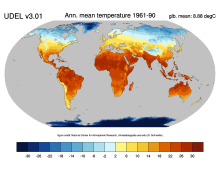 Global (land) precipitation and temperature: Willmott & Matsuura, University of Delaware
Global (land) precipitation and temperature: Willmott & Matsuura, University of Delaware
Years of Record
- 1900-01 to 2014-12
A series of gridded temperature and precipitation data sets. Station records that served as bases for the Terrestrial Air Temperature: 1900-2014 Gridded Monthly Time Series (Version 4.01) and Terrestrial Precipitation: 1900-2014 Gridded Monthly Time Series (Version 4.01)…
Main variables and Earth System components
Atmosphere Air Temperature Air Temperature at 2m Precipitation-
Timestep
- Climatology, Monthly
-
Domain
- Global
-
Collections
- Diagnostic Data Sets, NCAR-DOE-CESM, atmosdiagnostics
Experts contributing reviews
- Matsuura, Kenji
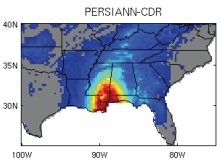 PERSIANN-CDR: Precipitation Estimation from Remotely Sensed Information using Artificial Neural Networks - Climate Data Record
PERSIANN-CDR: Precipitation Estimation from Remotely Sensed Information using Artificial Neural Networks - Climate Data Record
Years of Record
- 1983-01 to 2021-09
The Precipitation Estimation from Remotely Sensed Information using Artificial Neural Networks- Climate Data Record (PERSIANN-CDR) provides daily rainfall estimates at a spatial resolution of 0.25 degrees in the latitude band 60S - 60N from 1983 to the near-…
-
Timestep
- Sub-daily, Daily
-
Domain
- Global
-
Collections
- Climate Data Record
Experts contributing reviews
- Ashouri, Hamed | Gehne, Maria
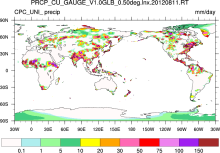 CPC Unified Gauge-Based Analysis of Global Daily Precipitation
CPC Unified Gauge-Based Analysis of Global Daily Precipitation
Years of Record
- 1948-01 to 2018-06
A gauge-based analysis of daily precipitation has been constructed over the global land areas. Gauge reports from over 30,000 stations are collected from multiple sources including GTS, COOP, and other national and international agencies. Quality control is performed…
Experts contributing reviews
- None
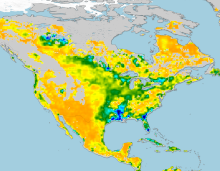 Soil Moisture Data Sets: Overview & Comparison Tables
Soil Moisture Data Sets: Overview & Comparison Tables
Years of Record
Soil moisture is a state variable of the land that crosses the interfaces of several disciplines, including meteorology, hydrology, climatology and ecology. Soil moisture content controls the partitioning of net radiation at the land surface between sensible and latent…
-
Formats
-
Timestep
-
Domain
-
Collections
- Overview / Comparison page
Experts contributing reviews
- Dirmeyer, Paul
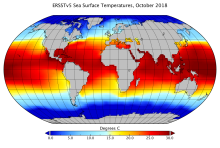 SST Data: NOAA Extended Reconstruction SSTs Version 5 (ERSSTv5)
SST Data: NOAA Extended Reconstruction SSTs Version 5 (ERSSTv5)
Years of Record
- 1854-01 to 2019-08
Note: ERSST is currently on version 6. See the ERSSTv6 page here. The NOAA Extended Reconstruction Sea Surface Temperature (ERSST) provides global, spatially complete SST data at a monthly timestep for 1854-present. Version5 is based upon statistical interpolation…
-
Timestep
- Climatology, Monthly
-
Domain
- Global
-
Collections
- Diagnostic Data Sets
Experts contributing reviews
- Hausfather, Zeke
Years of Record
- 1850 to Present
This overview focuses on SST datasets designed for climate applications. The focus is on datasets with coverage back to around 1850 at monthly resolution but select datasets over the satellite era that have been specifically developed as climate monitoring resources are…
-
Formats
-
Timestep
- Climatology, Daily, Monthly, Weekly
-
Domain
- Global
-
Collections
- Overview / Comparison page
Experts contributing reviews
- Chan, Duo | Kent, Elizabeth
 IMERG precipitation algorithm and the Global Precipitation Measurement (GPM) Mission
IMERG precipitation algorithm and the Global Precipitation Measurement (GPM) Mission
Years of Record
- 2000-06 to 2023-07
IMERG (Integrated Multi-satellitE Retrievals for the Global Precipitation Measurement) is NASA's updated precipitation algorithm, while the Global Precipitation Measurement (GPM) mission is an international satellite mission launched by NASA and JAXA on Feb. 27, 2014. The…
Experts contributing reviews
- Huffman, George J. | Tan, Jackson
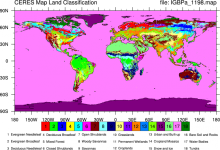 CERES: IGBP Land Classification
CERES: IGBP Land Classification
Years of Record
The International Geosphere–Biosphere Programme (IGBP) defines ecosystems surface classifications. The CERES (Clouds and Earth's Radiant Energy System)10-minute data can be used to derive the land categories.
Experts contributing reviews
- None
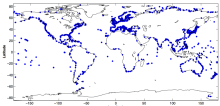 Tide gauge sea level data
Tide gauge sea level data
Years of Record
- 1800-01 to 2016-01
The global sea level record from tide gauges is an important indicator of the evolution and impact of global change. Tide gauge data also capture a variety of local and regional phenomena related to decadal climate variability, tides, storm surges, tsunamis, swells,…
-
Formats
-
Timestep
- Sub-daily, Daily, Monthly, Annual
-
Domain
- Global
-
Collections
- None
Experts contributing reviews
- Hamlington, Benjamin | Thompson, Phil
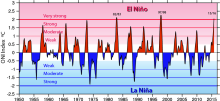 Overview: Climate Indices
Overview: Climate Indices
Years of Record
A climate index is a simple diagnostic quantity that is used to characterize an aspect of a geophysical system such as a circulation pattern. A variety of methods have been used to derive assorted indices. Classically, selected station, grid point or regional average data…
-
Formats
-
Timestep
-
Domain
-
Collections
- Overview / Comparison page
Experts contributing reviews
- None
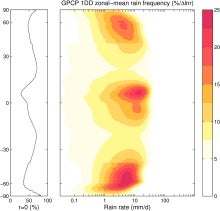 GPCP (Daily): Global Precipitation Climatology Project
GPCP (Daily): Global Precipitation Climatology Project
Years of Record
- 1996-10 to 2015-11
The 1DD product provides precipitation estimates on a 1-degree grid over the entire globe at 1-day (daily) for the period October 1996 - present. Both the Pentad and 1DD products are consistent with the Version 2 monthly product in the sense that the Pentad and 1DD…
Experts contributing reviews
- Pendergrass, Angeline
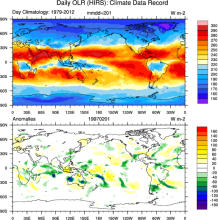 Outgoing Longwave Radiation (OLR): HIRS
Outgoing Longwave Radiation (OLR): HIRS
Years of Record
- 1979-01 to 2012-12
"The new Climate Data Record (CDR) provides daily global climate data that are valuable as inputs into Radiation Budget Studies and verifying numerical models and can identify the variations in tropical clouds and rainfall that drive global weather patterns. The daily…
-
Formats
- netCDF
-
Timestep
- Daily, Monthly
-
Domain
- Global
-
Collections
- Climate Data Record
Experts contributing reviews
- None
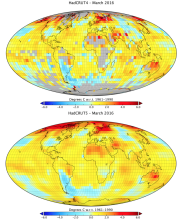 Global land-ocean surface temperature data: HadCRUT5
Global land-ocean surface temperature data: HadCRUT5
Years of Record
- 1850-01 to 2020-12
HadCRUT5 is one of the main datasets used to monitor global and regional surface temperature variability and trends. It is a global surface temperature product that combines land surface air temperatures from CRUTEM5 with SSTs from HadSST4. HadCRUT5 is a departure from…
Main variables and Earth System components
Atmosphere Air Temperature at 2m Ocean SST - sea surface temperature-
Formats
- netCDF
-
Timestep
- Monthly
-
Domain
- Global
-
Collections
- Diagnostic Data Sets
Experts contributing reviews
- Hausfather, Zeke
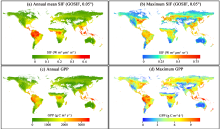 Global dataset of solar-induced chlorophyll fluorescence (GOSIF)
Global dataset of solar-induced chlorophyll fluorescence (GOSIF)
Years of Record
- 2000-02 to 2022-12
GOSIF is a global, gridded dataset of solar-induced chlorophyll fluorescence (SIF). SIF, an energy flux re-emitted by plants a few nanoseconds after light absorption, exhibits a strong linear relationship with gross primary production (GPP) at the ecosystem scale and…
Main variables and Earth System components
Biosphere GPP: Gross Primary Production solar-induced chlorophyll fluorescence (SIF) Land Gross Primary Production-
Formats
-
Timestep
- Monthly, Weekly
-
Domain
- Global
-
Collections
- None
Experts contributing reviews
- Xiao, Jingfeng | Li, Xing
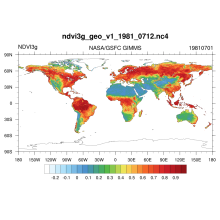 NDVI: Normalized Difference Vegetation Index-3rd generation: NASA/GFSC GIMMS
NDVI: Normalized Difference Vegetation Index-3rd generation: NASA/GFSC GIMMS
Years of Record
- 1981-07 to 2015-12
Normalized Difference Vegetation Index-3rd generation (NDVI) using the Global Inventory Monitoring and Modeling System (GIMMS): Vegetation indices are radiometric measures of photosynthetically active radiation absorbed by chlorophyll in the green leaves of…
Main variables and Earth System components
-
Formats
- netCDF
-
Timestep
- Daily
-
Domain
- Global
-
Collections
- Climate Data Record
Experts contributing reviews
- None
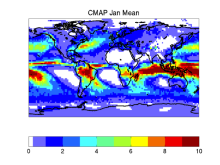 CMAP: CPC Merged Analysis of Precipitation
CMAP: CPC Merged Analysis of Precipitation
Years of Record
- 1979-01 to 2020-03
CMAP refers to a collection of precipitation data sets, though the 2.5°x2.5° global monthly version is probably the most widely used. This data set is constructed from an analysis of gauge data and satellite-derived precipitation estimates. An "enhanced" version (CMAP/A)…
-
Timestep
- Monthly, Pentad
-
Domain
- Global
Experts contributing reviews
- Arkin, Phil | Xie, PIngping